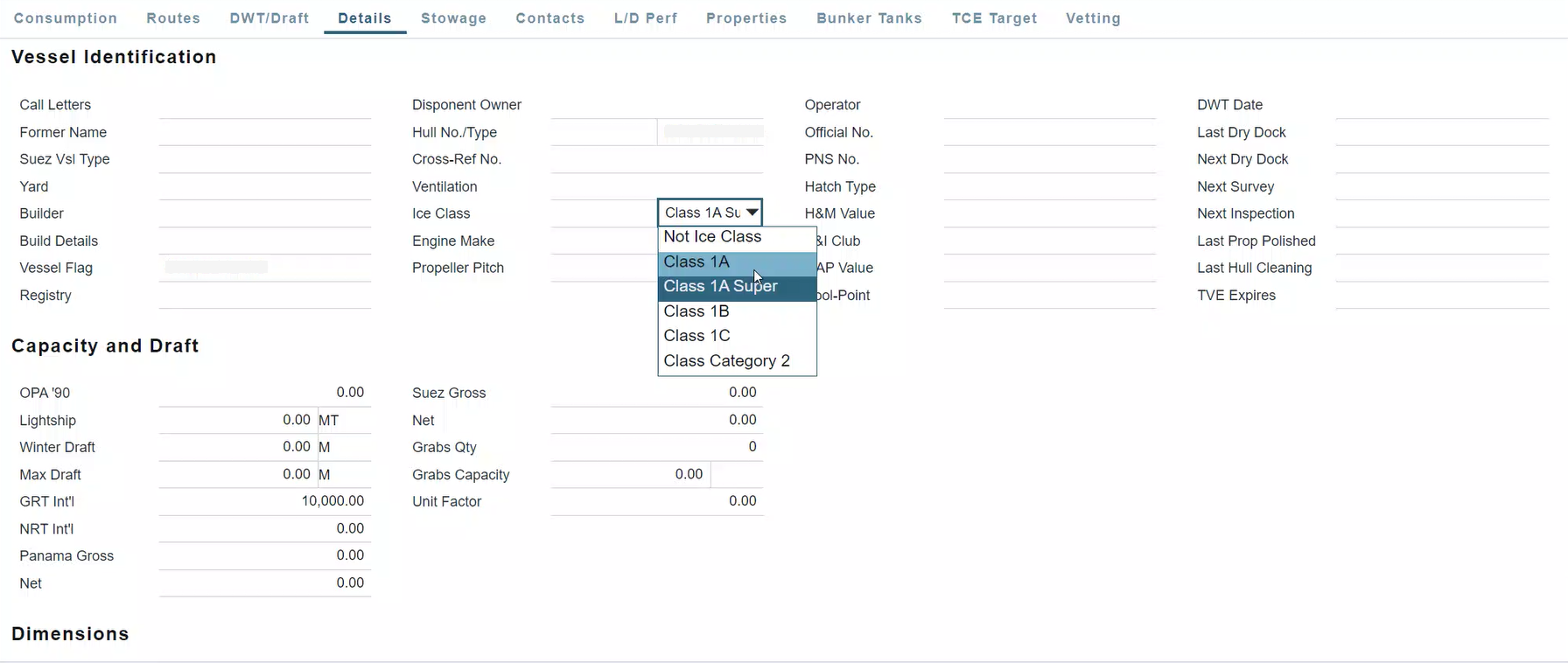IMOS - EU ETS in the Carbon Calculator
The Carbon Calculator allows you to incorporate ETS modifiers and apply a price to carbon emissions.
EU ETS percentages are included in Carbon Pricing. The percentage values for each leg of an itinerary will apply to the Carbon Cost calculation by default and will be determined by the Load and Discharge ports. You can also view the total EU ETS emissions in MT.
EU ETS Phase-in Logic
The Carbon Calculator supports EU ETS Phase-In percentages. The phase-in logic applies the relevant percentage for that year to the carbon expense and displays the values in the Phase-In % column. For cross-year scenarios, emissions will be allocated based on the portion of a voyage leg in a specific year.
Phase-in percentage per voyage leg:
2023 - 0%
2024 - 40%
2025 - 70%
2026+ - 100%
Inclusion of Methane and Nitrous Oxide in 2026
Starting in 2026, the EU ETS regulation will take into account both methane (CH₄) and nitrous oxide (N₂O) in addition to carbon dioxide (CO₂). The amount of allowances required when consuming fuels will increase due to these regulation changes. Charterers and Operators using traditional marine fuels will also need to account for CH₄ and N₂O emissions. The associated compliance costs will also apply the Cslip factor of the consumer unit to LNG consumption.
As a result of these changes, EU ETS emissions will automatically use the TtW CO2eq factor field instead of the CO2 Factor field for emissions calculations in the IMOS Platform starting January 1, 2026.
Sea and Port Consumption
You can view Sea and Port consumption separately. To improve the accuracy of calculated emissions values, the Sea ETS Emission (MT) and Port ETS Emission (MT) columns are editable for both Voyages and Voyage Estimates in the Carbon Calculator. When a field is overridden, the new value appears in blue text. If a field is cleared, it returns to the auto-calculated value in black text.

Berth versus Port Consumption
The Carbon Calculator assigns Anch In and Pilot-to-Berth emissions to the previous sea leg and Berth-to-Pilot and Anch Out emissions to the following sea leg. Consumption is prorated based on time and uses the following logic:
Anch In consumption is added to the previous sea leg (the sea leg associated with the current port call)
Alongside consumption is the port consumption in the Carbon Calculator
Anch Out consumption is added to the next sea leg (unless it is the last port call)
To view the Consumption tab in the Voyage Manager and add the Anch In, Alongside, and Anch Out fields to the Port/Date tab, visit the Voyage Manager - Consumption Tab article.
When Port Activities include ROBs, the berth consumption calculation uses the difference in ROBs between the first All Fast and the final Last Line Port Activity; this value updates the Port consumption in the Carbon Calculator. The consumption before berth arrival is added to the previous sea leg, and the consumption after leaving the Berth is added to the subsequent sea leg. This update reflects the EU ETS logic that defines sea legs as berth-to-berth.
For more information, see the following article: How to set up Port Activities ROBs to drive the Carbon Calculator (MRV/Berth-to-Berth)
Additional voyage legs
To improve the accuracy of emissions calculations, the system adds an additional leg to the Carbon Calculator itinerary grid under these three conditions:
the environment is upgraded to the latest schema (45.8)
the port call is the last one on the Voyage/Estimate
the port call has a Last Line Port Activity
In this case, this additional leg is considered sea, not port, consumption. This functionality works in conjunction with existing behavior that splits itinerary lines that cross years.
ROB data validation
All Fast and Last Line port activity fuel ROB values are validated on the Voyage Manager and Port Activity forms. ROB values are considered invalid if they show negative consumption or if some values are populated while others are missing. Invalid records are highlighted on the ROBs grid within the Port Activity form, and an error message is shown on the Voyage Manager validation display.
EU Port of Call fields
To account for the vessel position before and after the voyage and drive the correct ETS percentages, the Pre-Voyage Port of Call and Post-Voyage Port of Call fields are in the Carbon Calculator for Voyages and Estimates. When set, these fields impact calculated values in the Sea ETS % and Port ETS % fields.

EU ETS Exclusion (STS)
When the EU ETS Exclusion (STS) checkbox is selected for a port in the Port Properties Panel, the port will be excluded as a Port of Call from the Carbon Calculator to drive the correct EU ETS percentage.
Emissions for vessels below 5000 GT
According to EU regulations, EU ETS emissions do not apply to vessels below 5000T. When the GRT Int’l field in the Vessel Details Tab is below 5000, no ETS expenses or tonnage should be calculated.
As of 1 January 2025, companies must report emissions for the following ships:
Cargo and passenger ships of or above 5000 GT;
Offshore ships of or above 5000 GT;
Offshore ships and general cargo ships below 5000 GT but not below 400 GT.
Outermost regions
When the Outermost Region checkbox is selected in the Port Properties Panel, the system will account for Outermost Regions.
According to EU regulations, there are special rules for vessels traveling to outermost regions.
Until 31 December 2030, shipping companies must not surrender allowances for emissions released from voyages between a port located in an outermost region of an EU Member State and a port located in the same EU Member State (e.g. Lanzarote (Spanish Region)-Valencia (Spain)), including voyages between ports within an outermost region (e.g. Lanzarote (Spanish Region)-Fuerteventura (Spanish Region)) and voyages between ports in the outermost regions of the same EU Member State (Guadeloupe(French Region) -Martinique (French Region)). These exemptions include emissions within these ports in relation to such voyages.
The EU has nine outermost regions (ORs):
France: Guadeloupe, French Guiana, Martinique, Mayotte, Réunion, Saint Martin
Spain: Canary Islands
Portugal: Azores, Madeira
EU ETS is excluded from:
Legs between a port located in an outermost region of an EU Member State and a port located in the same EU Member State
Example: Lanzarote (Spanish Region) - Valencia (Spain)Legs between ports within an outermost region
Example: Lanzarote (Spanish - Canary Islands) - Fuerteventura (Spanish - Canary Islands)Legs between ports in the outermost regions of the same EU Member State
Example: Guadeloupe (French Region) - Martinique (Different French Region)
In alignment with the EU regulation, legs between ports in the outermost territories of a country or between a port in the outermost territory and the parent country will show ETS Sea and Port percentages of 0% by default.
Ice class vessels
Requires schema version of 443 or higher.
The system supports allowance reductions for ice class IA or IA Super vessel types in EU ETS emission calculations. With the EU ETS regulation, shipping companies may surrender 5% fewer allowances than their verified emissions from ships with ice class IA or IA Super or an equivalent ice class until 31 December 2030.
If the Vessel → Details → Ice Class is 1A or 1A Super, an Ice Class dropdown field is added to the Vessel Details tab. The 5% deduction is applied to the Total ETS Amount (MT), an Ice Class tooltip informs you of the discount in the Carbon Calculator, and the deduction carries over to the Voyage P&L.

